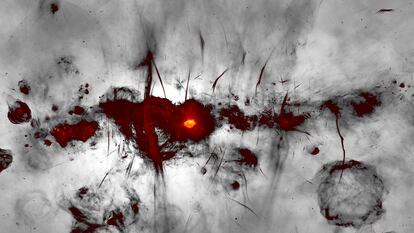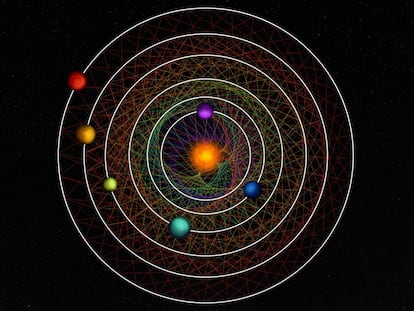What is between the stars of a galaxy?
The gases of the interstellar medium are the raw material from which stars are built. This is the fuel that keeps galaxies ‘alive’

For an inhabitant of Earth, with the naked eye, our galaxy appears as a faint strip of light that crosses the night sky. The name given to it during the ancient Greek civilization (which we still retain), the Milky Way, refers to its appearance: a “milk-white area” as described by Claudius Ptolemy (c. 100 - 170 AD). It was easy to see, and I say it was, because now it is only possible to appreciate it from the few privileged places that remain with access to a dark sky.
Over time and with the progression of telescopes, we’ve learned that this strip of light is actually a concentration of stars that’s shaped like a thin disk, with a radius of about 97,200 light years and a thickness of about 2,000 light years. That’s why it’s classified as a disk galaxy: it’s much larger in one direction than in the perpendicular, very similar to a vinyl record. The Sun resides in that galactic disk, about 50 light years above the median plane and 27,700 light years from the center.
In the center of the galaxy lives a supermassive black hole called Sagittarius A* and all the stars of the Milky Way rotate — with almost-circular orbits — in that disk, with a rotation speed that depends on their distance from the center. The rotation speed at the Sun’s position is about 136 miles per second. This means that our star takes 240 million years to complete an orbit around the galaxy. Since its birth, it has barely had time to orbit it around 19 times.
Although the stars are the most famous, we don’t know the true shape of our galaxy from them, but rather from observations of the gas found between them. It’s the simplest element — hydrogen in its neutral state — which shows us (with the help of radio telescopes) that the Milky Way has a spiral structure, similar to what’s observed in numerous external galaxies.
We’re always learning from the details of its shape, especially because it’s very difficult to determine the structure of something when you’re inside it. Imagine, for example, making a map of your city without having the possibility of leaving your home to plot the streets. Well, that’s the job of a person dedicated to this specialty of astronomy.
A galaxy is a very complex system: it’s not a simple aggregate of stars united by gravity. Between them, there exists a common reserve of gas and energy that we know as the interstellar medium. But now, let’s not fool ourselves: the interstellar medium isn’t a mere diffuse space that fills the gaps between stars. It could be said that it’s one of the most important components that a galaxy has. Although its density is very low when compared to that of the air we breathe, it controls most of its properties. Without the interstellar medium, there would be no stars.
But what is the interstellar medium made of? Well, above all, gas in all its phases (ionized, atomic and molecular), dust (tiny solid particles), high-energy particles and magnetic fields. It’s engaged in a continuous exchange of matter and energy with the stars — it’s highly heterogeneous and very dynamic.
Without going any further, in the vicinity of the bubble we inhabit — in the solar vicinity — there are five phases of interstellar gas, which is mainly hydrogen. On the one hand, there are clouds of cold dense molecules (at temperatures between -253 and -263 degrees), where stars form. Then, there’s atomic gas (at -173 degrees), which is almost transparent in the starlight, except at a series of specific energy points that give rise to traces in the form of absorption lines, which allow scientists to detect it. The presence of nearby stars or high-energy particles can strip electrons from atoms and give us two other gas components: the warm ionized medium (at 10,000 degrees) and the hot ionized medium, which is sort of like a galactic “baine-marie” bath with a temperature of millions of degrees. It surrounds everything and is fueled by the brutal energy of supernova explosions.
The entire interstellar medium is also peppered with magnetic fields, high-energy particles and solid particles (dust). And — if this isn’t already complicated enough — in order to determine the structure of each component, we require observations that cover different energy ranges: the 21-centimeter line of hydrogen and the cold, molecular clouds are observed via radio telescopes, while the hot medium is looked at through X-rays. For dust and molecular gas, we require infrared telescopes.
It’s important to remember that a galaxy isn’t a closed system… it lives in an environment of clusters and superclusters of galaxies. We’ve determined that, to maintain the rate of star formation since its formation, the Milky Way has had to receive fresh fuel almost continuously. And it seems that it’s been able to obtain it in the form of high-speed clouds, identified for the first time via the emission of atomic hydrogen at anomalous (non-galactic) speeds. Some of that gas originates in satellite galaxies, but some is ancient disk material that “rains down” like a galactic fountain.
Another part of that gas may be some of the hot material that — after being fed by supernova explosions — simply condenses and falls back to the plane of the galaxy.
Sign up for our weekly newsletter to get more English-language news coverage from EL PAÍS USA Edition
Tu suscripción se está usando en otro dispositivo
¿Quieres añadir otro usuario a tu suscripción?
Si continúas leyendo en este dispositivo, no se podrá leer en el otro.
FlechaTu suscripción se está usando en otro dispositivo y solo puedes acceder a EL PAÍS desde un dispositivo a la vez.
Si quieres compartir tu cuenta, cambia tu suscripción a la modalidad Premium, así podrás añadir otro usuario. Cada uno accederá con su propia cuenta de email, lo que os permitirá personalizar vuestra experiencia en EL PAÍS.
¿Tienes una suscripción de empresa? Accede aquí para contratar más cuentas.
En el caso de no saber quién está usando tu cuenta, te recomendamos cambiar tu contraseña aquí.
Si decides continuar compartiendo tu cuenta, este mensaje se mostrará en tu dispositivo y en el de la otra persona que está usando tu cuenta de forma indefinida, afectando a tu experiencia de lectura. Puedes consultar aquí los términos y condiciones de la suscripción digital.










































